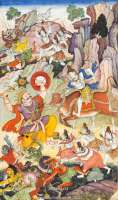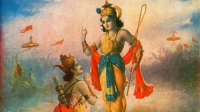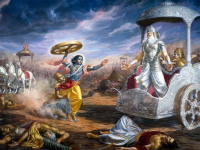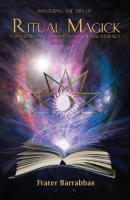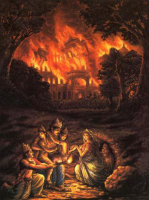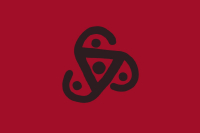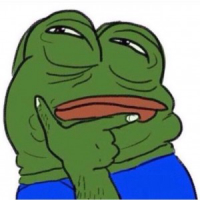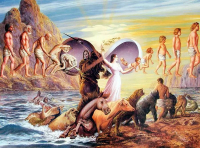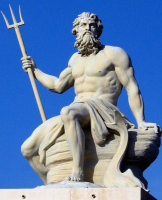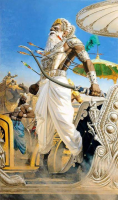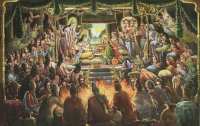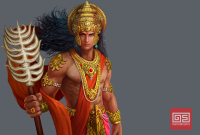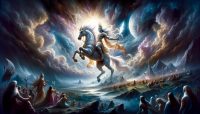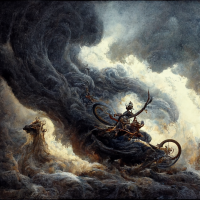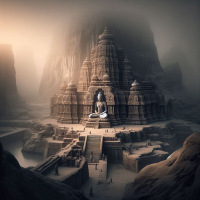Recent Posts
How to turn my atheist ass back to God
astrology
krishna was a chad >left the oneitis of his life at the age of 16 took sanyas from 16 to 21 >re-established dharma by making more ashrams >the ranchoddas waali kahani >many instances of his leela >in some thought krishna is held as the absolut...
Favourite part of mahabharat
Anyone has any idea about the pic related flag?
Dharmic perspective on masturbation
Duniya hasseno ka mela
Population and reincarnation
how do you stop the thoughts of going back to her? whats the evolutionary and psychological reason
What do you make of Greek Gods?
.
share ur experiences w higher entities/ lower entities I'll go first, last year before sleeping I used to see blood red eyes and patterns when I close my eyes and one day, my door slammed open, all the windows were closed, used to hear payal ki aw...
how to stop being pessimistic
Does Bhagwan Indra genuinely hate people with dark...
Kali Yuga Samaapti
The Asura-Deva aryan war
धर्मोत्तमानां चित्राणां सूत्रम् - /धर्मोत्तम/
God / ASI / Reality
God When i think about it, even though the philosophies across the world diverge but they also converge when we think about the creation of the universe, humankind...salvation, prophets, also the idea of soul, brahmin, etc. Lately, since 1 year or ...
The Asura-Deva aryan war
Bj9cmQ
Ahura-Mazda, the god of Persian Zoroastrianism, was the Vedic god Varuna, also known as Asura Medhira, he was the supreme god of the Indo-Iranians of India with Mitra, being the dual god Varuna-Mitra, before the Aryan invasion (yes, there were Aryans and caste system in India before the Aryan Invasion, that's why his caste system looks like more like the Spanish caste system than Jim Crow/Apartheid). The New Aryans replaced Varuna for Indra.
The Kuru people, who despite being considered part of the Indo-Aryan peoples, were to blame for degenerating the Vedas back in 900~800 BC, including the creation and canonization of the Atharvaveda in what previously constituted only three textual/oral bodies; Rigveda, Yajurveda and Samaveda. The bizarre thing about Atharvaveda is that it is from it that many magical formulas that were considered as sorcery in those times, fire worship and other practices not very accepted by the Indo-Aryans of that region emerged or were compiled. This Kuru people/federation was very linked to the Semitic peoples of Mesopotamia and as their first relations with the pure Aryans were very troubled, the bastards literally acted like Jews and gradually mixed until they were accepted and blended completely, the dates also match the Creation of Zoroastrianism and how As you well know, in the Avestan the Vedic gods are considered demons, the same technique that the Jews used in the Bible when demonizing deities other than Yahweh.
This is likely the cause of the Indo-Iranian split. In the Battle of the Ten Kings in the Vedas, an Aryan tribe finds itself cornered by other Aryan tribes. There the Vedas tell us that those Aryans had turned into Dasyus by worshipping the Asura, then the lone Aryan tribe of Trutsu-Bharata conducts a ritual of Ashvamedha (horse sacrifice) dedicated to Indra, before heading into battle. One of the “betraying” Aryan tribes is Pahlava/Parsu aka the Persians, who arrived in battle.
Bj9cmQ
Suddenly, Indra strikes from above, and “cast such hell upon them that their boldest were slain”. Indeed, this is also the first instance where a non-Aryan King, King Sudas, is given Aryan status for helping Indra’s loyal men. Because Indra says, that a former enemy is much better than a traitor.
>The Battle of the Ten Kings (Sanskrit: दाशराज्ञ युद्ध, IAST: Dāśarājñá yuddhá) first alluded to in the 7th Mandala of the Rigveda (RV), took place between a king of the Bharatas and a confederation of tribes. It resulted in a decisive victory for the Bharatas and subsequent formation of the Kuru polity. It is possible that the Battle of the Ten Kings, mentioned in the Rigveda, may have "formed the 'nucleus' of story" of the Kurukshetra War, though it was greatly expanded and modified in the Mahabharata's account. The term 'Mahabharata' itself implies a reference to this war through the prefix Maha- before Bharata i. e. – Great Bharatas or Victory to the Bharatas
>The Battle of the Ten Kings led Bharatas to occupy the entire Puru territory of Western Punjab (then Panchanada) centered around Sarasvati River and complete their east-ward migration. Sudas celebrated his victory with the Ashvamedha ritual to commemorate the establishment of a realm, free of enemies from the north, east, and west. He still had enemies in the Khāṇḍava Forest to the south, which was inhabited by the despised (unknown if Indo-Aryan or non-Indo-Aryan) Kikatas
>A political realignment between Purus and Bharatas probably followed soon enough and might have included other factions of the tribal union as well; this is exhibited from how the core collection of RV prominently features clan-hymns of both the sides
Bj9cmQ
The appearance of the Gnostic Demiurge comes from Mithraic Arimanius. Mithraism was an Eastern Mystery religion popular among the Roman Empire Army during the rise of Christianity which was introduced to Rome by the Silician Pirates. Mithras comes from the Vedic god Mitra, who was part of the dual god Varuna-Mitra, Varuna was called Asura Medhira and then Ahura-Mazda, while Mitra was separated between Mithra and Ahriman, who was the evil twin brother of Ahura-Mazda, both are sons of Zurvan.
It's probably that the Mithraic cult was an underground Magi cult worshiping Ahriman. Ahriman killed the prime bull Gavaevodata and the most famous image of Mithras is him killing a bull, the seven degrees of initiation may have represented the 7 archons/planets underneath the Chief Archon, Yahweh/Yaldabaoth. Many Mithraeums had statues of lion-faced man-serpents, very likely representing the Chief Archon, and in fact at least one was recovered with an inscription identifying the figure as Ahriman, who is also called Angra Mainyu.
Zoroastrians derived from their predecessors the Magi, but they absolutely hated the Magi. In fact they even had a holiday called Magophania where you could kill any Magi you meet. This was because the Zoroastrians only worshipped the good principle, Ahura Mazda, the Iranic version of God, while the Magi before them also worshiped the evil principle, Ahriman, the Iranic Satan, and his Devas, and justified this saying that he is the eldest son of Zurvan wuo created the material world. Direct descendants of the real Magi today are the Yezidi, they are devil-worshippers (the peacock angel Melek Taus, also known as Azazil).
https://archive.org/details/FromTheAshesOfAngelsTheForbiddenLegacyOfAFallenRaceByAndrewCollins
https://libgen.rs/book/index.php?md5=A9778F39F2F604682F83C91039641356
Bj9cmQ
www.academia.edu/43814750/Ahura_Origin_and_Etymology
>"Ahura” was originally an adjective meaning ahuric, characterizing a specific Indo- Iranian entity named (Asura)/*Hasuras. Although traces of this figure are still evident in the oldest texts of both India and Iran, in both cultures the word eventually appears as the epithet of other divinities as many believed Ahura or Ásura were class of deities which were first created in early Vedic and Gathic, has possibly IE or for certainty Proto IIr roots, Ásurah as Proto Indo Iranian *nsuras (indo-Iranian as*hásura(s)) as root of PIE *H2ensu, as in Veda Indra called sometimes Ásura and then he joined the rank of devas as mentioned 88 times in Veda
>For similar words with near phonetic, Ašerah mentioned as feminine form and consort of supreme Canaanite god EL, mother goddess and fertility and with pole or phallus, or other forms of it in Akkadian and Assyrian inscriptions rendered as Assura/Assara. Ahura is synonymous with the Vedic word Ásura/Asura(h) which means "lord". Finnish Indologist, Asko Parpola, traces the etymological root of Asura to *asera- of Uralic languages or variations of azoro, azor same language where it means "lord, prince", and also possibly as ruling lord, and also possibly engenderer of a family Av ahura = OInd asura and Av Mazdā is an adjective meaning literally one who puts everything in his mind [as we know ahura/asura is attested in other cultures like Babylonian and Assyrian inscriptions dated tentatively between 13 th BC and 8 th and 7 th BC as well with another epithet mazdā/mazaš which can be seen as joint two epithets to form a singular supreme deity but also in Assyrian inscription of 7 th BC and also in Many parts of Gathas they are used separately as well] in many other languages like OP is Ahura/Aura/Auara Assyrian/Akkasian Assara ( asara/as-sa-ra) and Elamites Ura/U(a)ra
Bj9cmQ
>Ahura means high being (possible shining as dyaus). Initially worshiped alone, then later in a triad with Mithra and Anahita in Achaemenid system or with Varuna (a.k.a. Apam Nahat). He made his first appearance in the Achaemenid period in the Behistun inscription sometime between 522 BC and 486 BC. The word Ahura means [infinite] light and Mazdā means wisdom. Thus Ahura Mazdā is the lord of light and wisdom or life-giving and ahu and ra as life or wealth, asu in Vedic. “In the Rig Veda he was, although dreaded, at the same time worshiped as the god who initiated his devotees as mystical seers (7.88); i.e., he made them médhirā "wise" like himself (7.87.4). This wisdom. "(Revealed) insight into the cosmic order" (medha rtasya) or medhá as wisdom, was the exclusive privilege of seers (8.6.10)
>Iranian mazdā was equivalent to médhirā. Early IIr. Religion focused on the contrast between the deva and the asura: IIr *daiua, Av. daẽuua, OP. daiva :: IIr. *asura, Av. ahura, OP. ahura-(Mazda). In the RV both groups are regarded as are 'gods' probably due to their equal status in the New Year contests -- and only in the post-Rig Vedic texts, the Asura have definitely become demon-like. Of the major Asura (or, Āditya) Varuna, sometimes called Asura and medhira/medhå in the RV12 appears in the Avesta as Ahura mazdå (cf. Ahura and Miθra, Y. 17.10), Mitra as Miθra, Aryaman as Airiiaman, Bhaga as Baγa, Vivaśvant (Mårtåda) as Vīvhuuant, and Mårtåda's brother Indra as the demon Indara. While Zaraθuštra kept Ahura Mazdå as (sole and supreme) deity, the Ahura, all other IIr. deva (Av. dāẽuua) are relegated to the ranks of demons, e.g. Indara, Gandarəβa (Gandharva), Nahaiθiia (Nåsatya = Aśvin). A few devas and asuras were retained, In Buddhism, the Asuras are known as Jealous Gods
Bj9cmQ
>In the Shambhala tradition, Asuras are known as "Feisty Gods” (in later Vedic and Buddhist circles asuras mentioned as demons) the perceive meaning of OInd asura, OAv ahura is not known precisely but can be interpreted as ruling lord seems to be the implication in Avesta but it may originally meant engenderer hence master (of the family) pater families…] and also it seems to be a tribal tutelary god of specific Iranian tribe (separated from Yaz cult 1500-700 BC). My main argument here is not relation of ahura to other deities of YAv but merely is examining Ahura itself in isolated manner
>Designation of a type of deity inherited by Zoroastrianism goes back to the prehistoric Indo-Iranian religion. In the Rig Veda, asura denotes the "older gods," such as the "Father Asura" (10.124.3), Varuna, and Mitra, who originally ruled over the primeval undifferentiated Chaos. The emergence of the dualistic cosmos was a process of polarization in which some of the asuras, such as Agni (Fire), Soma, Varuna, and Mitra, went over to the "younger gods," the Devas. The other asuras were driven away from the earth and remained as exiles in the nether world. The Rig Veda still preserves a terminological distinction between" asuras that have become devas" (deva asura 8.25.4, cf. 7.65.2) and "asuras that are non-devas". Many etymologies word ahura (OInd Asura) derived from old verb meaning engender (Hittite has/-hashsh) ,relation between Aesir and old Norse word meaning gods (sing as god) and asuraha Sanskrit word certain warlike and aggressive demons in avestan as ahura .The Iranian term ahura ("lord") corresponds to the Vedic asura. Whereas in the Vedas asura is usually applied to Dyaus-Pitṛ ("father sky"), the Indian equivalent of the Roman Jupiter, in Iran and in the Zoroastrian tradition ahura is applied to three divinities: Ahura Mazdā, Mithra, and Apąm Napāt ("son of the waters")
Bj9cmQ
>Some scholars see Apąm Napāt as the Iranian counterpart of Varuṇa, the first of the asuras, and have called him *Vouruna Apąm Napāt in an attempt to reconstruct a unitary structure of three original Indo- Iranian asuras, with Ahura Mazdā corresponding to Asura *Medhā, Mithra to Mitra, and *Vouruna Apąm Napāt to Varuṇa Apām Napāt (Boyce, 1975). These arguments, however, are not very convincing. Other scholars suppose that at the summit of an ancient Indo-Iranian pantheon was a god called Asura/Hásuras, without further characterization, who survived in Iran to some extent in the Ahura Mazdā of Zarathushtra (Zoroaster), but who in India abandoned the field to Varuṇa (Hillebrandt, 1927; Gershevitch, 1964). This thesis, however, is also not certain is good to mention here the deity lists in Assurbanipal 7 th BC text includes the term Asura as Assara which accordingly can be a nominative singular or plural form of Asura of proto Iranian or even a deformed IIr (Indo-Iranian) version petrified in this manner, I believe Assara as is written in Akkadian cuneiform as-sa-ra is a corrupted form of as-su-ra of Proto Iranian which was mentioned in either 13 th or 7 th BC text, indicating existence of this term as a Iranian or non-Assyrian deity within Assyrian influences, and only the second term mazaš can shed light to origin and history behind this collocated asyndetically deity
>Furthermore in both Iran and India, the term ahura/asura designates a class of gods or, to be more exact, a class of ruling gods (Dumézil, 1977), but their fate on either side of the Indus was different. Whereas in India the asuras came to represent the most archaic divinities, against which the devas, the "young" gods, asserted themselves, in Iran it was one of the ahuras, Ahura Mazdā, who displaced all the daivas
Bj9cmQ
>Thus, when Zoroastrianism reached a compromise with the ancient polytheism that had originally been condemned by Zarathustra, the other ahuras, such as Mithra and Apąm Napāt, were readmitted to the cult, while the daivas, whose nature was bellicose and violent and who were above all warrior gods (Indra, for example), were totally demonized. It is quite likely that the ahuras were able to maintain their privileged position in the Zoroastrian tradition thanks to their ethical nature and to their special function as guardians of aša (Vedic, ṛta, Op arta), truth and order, a fundamental concept of Indo-Iranian religions in general as well as of Zoroastrianism in particular
>Ahura/Asura also shall be examined outside Indo-Iranian sphere as it may have had roots of IE and also Non-IIr such as mentioned in Kassites and Babylonian and Assyrian either independently or influenced or borrowing from IIr people, and also was used arbitrary and quite randomly and some in formula in Gathas as opposed to later Younger (standard) Avestan and Old Persian time as one single word. the form Assura/Assara in Assyrian and Akkadian inscriptions of 13 th to 7 th BC clearly means either Indo-Iranian people were present in these areas long before Proper Iranian migrated here and also show Ahura/asura were deity which these inscriptions mentioned many times, it also shows before Zarathustra started his religion Ahura was a deity worshiped by Indo-Iranians or even proto Iranian before *s>h changes as later we see in Gathas and YAv texts, form of Assara in 7 th BC text shows ahura alone was also worshiped and recognized as there was divinity sing before it and also before Mazaš which could point to separate deities or even in wild imagination would also follow the arbitrary terms used in Gathas itself which would use these two ahura and Mazdā in separate terms as well
Bj9cmQ
>Ahura/Asura has been in Vedic and Avestan texts centuries before appear in Old Persian and Achaemenid inscriptions and was always a case of controversy and discussions among scholars, Avestan ahura derives from Indo-Iranian Hásuras, also attested in an Indian context as Rig Vedic asura. As suggested by the similarity to the Old Norse æsir, Indo-Iranian asura may have an even earlier Indo-European root…..It is commonly supposed that Indo-Iranian Hasura(s) was the proper name of a specific divinity, with whom other divinities were then identified and For not altogether obvious reasons, the Oxford English Dictionary lists asura, rather than ahura, as a Zoroastrian term
>Asuras were later in late Vedic demonized but were sacred and worthy of worships in Avestan. In the later texts the term asura is limited to the latter group. Varuna was incorporated into the ordered world as the lord of the subterranean world, including the cosmic waters on which the earth rests, and of the cosmic law (Rta) but his character remained ambiguous; in many etymologies word ahura (OInd Asura) derived from old verb meaning engender (Hittite has/-hashsh) concept of supreme god as the progenitor in the ancient expression dieus pater (father heaven) which survives in Latin as Jupiter.. Supreme deities as father of gods and as IE dieus pater (father heaven with expression pataram vanhaush in Veda), The Iranian pantheon was similar to that of other Indo-European religions. It contained a large number of deities, primarily male. These deities personified natural phenomena, social norms or institutions. It seems that there were two major groups of deities, the Daivas and the Ahuras. Daiva, which means "heavenly one", is derived from the common Proto-Indo-European word for "god", which is the meaning it has in the Vedas. Among some Iranians and in Zoroastrianism the Daivas/deva/dāeuua was considered demons, but this view was not universal
Bj9cmQ
>The Ahuras ("lords") were noble sovereign deities. They were contradicted with the baga ("the one who distributes") and the yazata ("the one who worshipped"). Partisans of order as the ancient Iranian imagined a world with order and chaos constantly vied for supremacy. Were heavenly powers with Ahura Mazdā, all knowing ruler at their head who combated chaos in the form of darkens decay and death to reestablish order in the form of light growth and life Common derivations of the name for the Sky God worshiped by the PIE’s *Deiwo, can be found In many IE Languages Deus in Latin, Zeus [Theo’s] in Greek, Tiw in Old English-Tuesday , Iranian and Indian variants of Dyaos’ and Dyaus who has become so remote no longer worshiped by time of Avestan and Rig Veda were composed, There were deities beside ahura mazdā both good and bad ,, bad ones called Av dāeuuas the old gods, chosen to side with evil ruler was evil spirit (angra mainyu) female one. One of the first tirades of indo Iranian stage shall be ahuramzdā , apam napat (vouruna) and mithra all male deities and all three of them had ahura epithet. Boyce 1986 – 150 1982 219
Etymologically, "Aesir", "Asura", and "Ahura" are all cognates, and they just mean "Lord". In the earliest strata of Vedic texts "Asura" just means "lord" and is used to refer to lords in general, human, divine, or otherwise. The "emperor" of the Hittite Empire (actually the high priest of the priesthood of the King of the Gods of the city of Nesha) was the "Hashu", which comes from the same root (his wife, who was his adopted sister and was the high priestess of the priestesshood of the Queen of the Gods of the city of Nesha, was the "Hashuanna").
Bj9cmQ
There's an idea in IE religions of the Gods and the anti-Gods (aka demons). Zoroaster creates his own pantheon of Gods that are basically identical copies to those of "Iranic Hinduism" but operate according to Zoroastrian morals. In other IE religions, the Aesir/Vanir and Olympians are the Gods, and the Jotunns/Titans were the anti-Gods. "Anti-God" is a faction, not necessarily a race, so non-chaotic extra-divine entities can be recruited (usually via marriage). Freyr marrying Gerðer is an example. Orderly agents can also "go rogue", such as Prometheus and Loki (both of whom are a sort of "dangerous uncle" figure that, well, goes rogue).
In the Asura-Deva War (Asuras led by Shukra, Shukra is the son of Maharishi Bhrigu who is a mind born son of Varuna, and Bali and Devas led by Brihaspati and Indra) at Ocean of Milk, Rahu tricked the Deva's and was about to drink Amrita, Elixir of immortality. Deva's spotted Rahu and cut off his head. His head became immortal and chief advisor of Asura's. At the conclusion of the Aesir-Vanir War at Well of Magic, fearing trickery from the Aesir, the Vanir beheaded Mimir and returned his head to Asgard. Odin preserved the head of Mimir with magic so Mimir can be his advisor. Njordr the leader of Vanir was in an ill-fated marriage with the goddess Skadi. Shiva who sometimes leads the Devas in war also had an ill fated marriage with Shakti/Sati. Shiva has a Jyotir Linga form. Brihaspati, the leader of Devas too was in an ill fated marriage. Name of Indra's wife is Schachi which sounds similar to Skadi.
Bj9cmQ
Loki is a trickster. Purandara/Indra, god-king of heaven, is notorious for various tricks and tactics and the most criticized god in Indian mythology. Norse believed Loki imprisoned their gods. Vali, unfortunate son of Loki. Purandar's son is Vali who was cursed to become a Vanara (forest/monkey man) and unfortunately died at the hands of Rama. Baldr is the greatest king of Aeisir. Bali is the greatest Asura king. The whole world did weep for the generous son of Odin, Baldr. Bali is probably the most generous king in Indian mythology. Baldr will return at the end of Ragnark. Bali will return as Indra at the end of this Manavantara. Bali ruled the earth as Emperor. Bali was Daitya division of Asura. Odin can raise the dead. Shukra too can rasie the dead.
Just as the Vedic Gods were considered Asuras, The Norse Gods were all Jotuns. If you read Norse Cosmology you will find that Odin, Loki and Hoenir were brothers. They created the world (by murdering Ymir) and mankind. The father of the three brothers was Borr, son of Búri, both have similar names and are the Norse equivalent of the Proto-Indo-European Manu brother of Yemo (Ymir, the father of the Jotuns), and the mother Bestla. Bestla, was a jotun. Thus as much can be deduced that the sons of Mannus, Odin/Irmin, Loki/Istaev/Ve/Lodurr and Hoenir/Ing/Vili were part jotun as well. Odin becomes leader of the Aesir, Loki becomes leader of the Jotunn during Ragnarok and Hoenir becomes leader of the Vanir.
Now I would argue that Bor and Bestla are the same as Farbauti and Laufey who both were jotuns and also had three sons - these were Loki, Byleistr (storm rouser, storm lightning) and Helblindi ("All-blind"). Now as I have already explained. If Loki is the brother of Odin and Hoenir, and Buri and Bestla being their father. Byleistr (storm-roser) is certainly the same as Hoenir, and Helblindi (All-blind) the same as Odin. Thus all the norse gods are jotun descend
Bj9cmQ
Satan is a copy of Ahriman and not the other way around, memeflag. Christianity is more Theologically Influenced by Second Temple Jewish Apocrypha inspired by Zoroastrianism than the OT. One exception to this is the book of Daniel. People say that Christianity's views on the spirit world were made up by the Romans but Second Temple Jewish apocrypha had Abraham's Bosom, had different levels of sheol, had a fiery part of Hades where people burned in torment, talked about the judgement day and eternal sentencing for some, talked about angels being imprisoned in Tartarus and spirits in prison, talks about angels being tempted by women and breeding with them, talks about multiple levels of heaven, talks about the Son of Man being given power from the Ancient of Days, talks a lot about demons and evil spirits. Powers, principalities, and dominions are things people fight against in the NT.
>"For in Him all things were created, things in heaven and on earth, visible and invisible, whether thrones or dominions or rulers or authorities. All things were created through Him and for Him." (Colossians 1:16)
Thrones, dominions, rulers, and authorities are spirit beings. Jesus and Judas quoted Enoch and other Jewish apocrypha, Paul mentioned things in Jewish apocrypha and so did John. All of Paul's beliefs about Satan being an evil dualistic being were inherited from quirky Jewish apocalyptic sects heavily influenced by Zoroastrian thought.
jz++8G
>>5381
Indra often comes up in my dream.
I asked him Lord why did the Aryans fall.
He said it was necessary for a new age to start. No one is to blame.
Bj9cmQ
>*Manu and *Yemo were a duo in Proto-Indo-European mythology. In the creation myth, Manu kills Yemo as a foundational part of the origin of the universe. Yemo is sometimes also interpreted as a primordial hermaphrodite
>The comparative analysis of different Indo-European tales has led scholars to reconstruct an original Proto-Indo-European creation myth involving twin brothers, *Mónus ('Man') and *YémHos ('Twin'), as the progenitors of the world and mankind, and a hero named *Trito ('Third') who ensured the continuity of the original sacrifice
>Although some thematic parallels can be made with Ancient Near East (the primordial couple Adam and Eve), and even Polynesian or South American legends, the linguistic correspondences found in descendant cognates of *Manu and *Yemo make it very likely that the myth discussed here has a Proto-Indo-European (PIE) origin
>Lincoln reconstructs a creation myth involving twin brothers, *Manu- ("Man") and *Yemo- ("Twin"), as the progenitors of the world and humankind, and a hero named *Trito ("Third") who ensured the continuity of the original sacrifice. Regarding the primordial state that may have preceded the creation process, West notes that the Vedic, Norse and, at least partially, the Greek traditions give evidence of an era when the cosmological elements were absent, with similar formula insisting on their non-existence: "neither non-being was nor being was at that time; there was not the air, nor the heaven beyond it..." (Rigveda), "...there was not sand nor sea nor the cool waves; earth was nowhere nor heaven above; Ginnunga Gap there was, but grass nowhere..." (Völuspá), "...there was Chasm and Night and dark Erebos at first, and broad Tartarus, but earth nor air nor heaven there was..." (The Birds)
Bj9cmQ
>To the third man Trito, the celestial gods offer cattle as a divine gift, which is stolen by a three-headed serpent named *Ngwhi ('serpent'; and the Indo-European root for negation)
>Trito first suffers at his hands, but fortified by an intoxicating drink and aided by a helper-god (the Storm-God or *H2ner, 'Man'), together they go to a cave or a mountain, and the hero finally manages to overcome the monster. Trito then gives the recovered cattle back to a priest for it to be properly sacrificed. He is now the first warrior, maintaining through his heroic deeds the cycle of mutual giving between gods and mortals
>Cognates deriving from the Proto-Indo-European First Priest *Manu ('Man', 'ancestor of humankind') include the Indic Mánu, legendary first man in Hinduism, and Manāvī, his sacrificed wife; the Germanic Mannus (from Germ. *Manwaz), mythical ancestor of the West Germanic tribes; and the Persian Manūščihr (from Av. Manūš.čiθra, 'son of Manuš'), Zoroastrian high priest of the 9th century AD
>From the name of the sacrificed First King *Yemo ('Twin') derive the Indic Yama, god of death and the underworld; the Avestan Yima, king of the golden age and guardian of hell; the Norse Ymir (from Germ. *Yumiyáz), ancestor of the giants (jötnar); and most likely Remus (from Proto-Latin *Yemos), killed in the Roman foundation myth by his twin brother Rōmulus. Latvian jumis ('double fruit'), Latin geminus ('twin') and Middle Irish emuin ('twin') are also linguistically related
Bj9cmQ
>Cognates stemming from the First Warrior *Trito ('Third') include the Vedic Trita, the hero who recovered the stolen cattle from the serpent Vṛtrá; the Avestan Thraētona ('son of Thrita'), who won back the abducted women from the serpent Aži Dahāka; and the Norse þriði ('Third'), one of the names of Óðinn. Other cognates may appear in the Greek expressions trítos sōtḗr (τρίτος σωτήρ; 'Third Saviour'), an epithet of Zeus, and tritogḗneia (τριτογήνεια; 'Third born' or 'born of Zeus'), an epithet of Athena; and perhaps in the Slavic mythical hero Troyan, found in Russian and Serbian legends alike
>*Ngwhi, a term meaning 'serpent', is also related to the Indo-European root for negation (*ne-). Descendent cognates can be found in the Iranian Aži, the name of the inimical serpent, and in the Indic áhi ('serpent'), a term used to designate the monstrous serpent Vṛtrá, both descending from Proto-Indo-Iranian *aj'hi
Manu = Búri/Borr
Yemo = Ymir
Trito = Odin
Trito evolves into Thirdi (Þriði) in the Germanic/Norse pantheon, which is merely a manifestation of Odin. And Odin is already known to be the same as the Roman Mercury, and therefore the same as Greek Hermes. Odin was originally in the same way like him, both are depicted carrying a staff and wearing a wide-brimmed hat, and both are travelers or wanderers. However, these relations go beyond superficial similarities; both gods are connected to the dead (Mercury as 'psychopomp' - the only god allowed in both Olympus and the underworld - and Odin as lord of the dead in Valhalla), both were connected to eloquent speech, and both were associated with secret knowledge. Hermes was called Trismegistus (Three Times Great), in the same way that Odin is Tritus (Third) and is the third of the two brothers Hoenir and Loki.
Bj9cmQ
The symbol of Mercury is the female symbol of Venus (Aphrodite) with horns, this is because Hermes and Aphrodite merged into the Hermaphroditus. This is why Odin is called a faggot by Loki in the Eddas and Odin priesthood wore robes, female garb. Hermes-Mercury/Odin is the third in all things, even sex/gender, hue.
>The symbol for Mercury is a caduceus (a staff intertwined with two serpents), a symbol associated with Mercury / Hermes throughout antiquity. Some time after the 11th century, a crosshatch was added to the bottom of the staff to make it seem more Christian
>The symbol has also been used to indicate intersex, transgender, or non-binary gender. A related usage is for the 'worker' or 'neuter' sex among social insects that is neither male nor (due to its lack of reproductive capacity) fully female, such as for example worker bees. It was also once the designated symbol for hermaphroditic or 'perfect' flowers, but botanists now use for these instead
Bj9cmQ
Odin comes from Wodanaz, who comes from the PIE Root "-odr" which means "to howl (furiously), whose name comes from this root is Rudra (a God of Howling Storms, Hunting, and having a "THIRD eye"). Rudra is treated as a lesser emanation of Shiva in the Rig Veda, because Rudra is an Aryanized version of Shiva and is associated with hunting animals unlike the friend of animals Pashupati (Shiva's oldest form, that is EXPLICITLY known as a deity of vegan dalits and forest animal herder tribes). The TRIMURTI is a concept in Hinduism in which the cosmic functions of creation, maintenance, and destruction are personified by the forms of Brahma the creator, Vishnu the maintainer or preserver and Shiva the destroyer or transformer. These three deities have been called "the Hindu triad" or the "Great Triple deity", Shiva being the THIRD god as Odin/Hermes/Mercury is the Trito/Trismegistus/etc..., you guys already understand.
Bj9cmQ
BTW Pashupati. Yoga date back to Harrapan IVC with him, a horned figure with several faces cross-legged/meditating around animals, looking like Cernunnos, which is a primitive form of Lugh, which is interesting since that there is a statue of Shiva at CERN which is in Switzerland, a Celtic land.
Now Shiva is considered to be the first Yogi, and his tradition is said to date back long before most traditions, he is one of the first and prime gods in latter hinduism, but still there is a representation in IVC, which may indicate some form of physical exercise regiment created to keep peoples transferring from active lifestyles of hunter gatherers, herders to more sedentary and urban lifestyles and to instill in them calm and disabuse notions and need to be restless.
Angry Shiva, in his Prototypical Rudra form, was the destroyer of Asura that is the Iranians. The imagery is of someone who despises Iranian Panis and Dahyus for threatening Vedic Aryans. But since it known that Vedic Aryans were very bad at naming new things, they named the Indian natives, Asura born, demons and Mayavis Once inside India, Shiva actually becomes a sympathetic figure to Asuras, social outcasts and lower castes, is hated by Vishnu worshipping Brahmins, becomes patron deity of mostly non-Aryan societies and it is very clearly depicted in the Puranic traditions. The competitive aspect of Vishnu and Shiva is the core of Shiva's marriage to Shakti, the daughter of a prominent Aryan King who sees Shiva as unacceptable. Like Romeo and Juliet, Shakti falls in love with Shiva but dies when King disrespect Shiva.
An angry Shiva here goes ahead and behead the King. Throughout the stories, he is benign to Asuras (now natives) and cares for their well-being but due to Aryan influence (biased narrative) act against them. The famous native King Ravana was a supreme Shiva worshipper and Aryan narrative of Ramayana glorifies his killing.
Bj9cmQ
musingsfromgellifach.blogspot.com/2011/07/concerning-cernunnos-part-3-cernunnos.html
>So how do these two gods relate to each other? Rather tantalisingly Alexei suspects that the answer lies in a now-vanished element of Gaulish mythology. But looking to the later insular literature, he notes that Manannán is Lúgh’s foster-father and in the Welsh Mabinogi, Gwydion is Lleu’s foster-father and says that if we observe that “both characters are older versions of the young hero in their talents and attributes, and indeed very “Mercury”-like [the Celtic Mercury which he equates with Lugus] – we may indeed come very close to understanding the nature of the relation.”
>(As an aside, note that in the third branch of the Mabinogi there is another nature versus culture myth. But this time it is Manawyddan fab Llyr, who is related to the Irish Manannán, who takes on the role of the character who defeats the malign powers of the Otherworld, an army of mice who eat the crops, and he uses trickery to defeat them and restore the Land for the tribe.)
>Now I am not very sure what understanding Alexei thinks we may come to by considering these older versions of the young hero. Possibly it relates to my own speculation - that, of ‘the Old Gods’, Cernunnos is a Very Old God, a kind of precurser to Lúgh from the age of the hunter
>Consider the rock carvings at Val Camonica which give us the earliest depiction of an antlered god in a Celtic context. These petroglyphs are amazing in that they span a period of about 8,000 years and show a development of ideas through the different ages. The earliest carvings, well before the rise of the Celts, are from the Mesolithic period (8th –6th millenium BC) and were made by nomadic hunters. They depict their prey - typically deer and elk
MTyb8m
why not post it in >>>/rta/? Don't have an issue if you want to carry on discooshun here.
Bj9cmQ
>>5401
Well not much activity going there so i thought posting on /b will be okay,
Can you move the thread to /rta ?
Bj9cmQ
>In the Neolithic period, with the beginning of agriculture (5th – 4th millennium BC), human figures and geometric patterns, rectangles and circles among others, appear, giving perhaps the idea of fixed settlements. By the Bronze Age, roughly the 2nd millennium BC, weapons began to appear, along with the geometric shapes, and in the Iron Age (1st millennium BC), where our first depiction of ‘Cernunnos’ comes from, the Camunni people carved symbols of “heroic masculinity and superiority. Dominant themes include representations of duels and human figures…flaunting their weapons, their muscles and their genitals. There are also figures of cabins, labyrinths, footprints, hunting scenes and other symbols.” (Source: Wikipedia)
>The point I want to make here is that humankind’s relationship with stags goes far, far back into the Mesolithic age when they were hugely important as prey. It's true that it wasn’t until the Iron Age at Val Camonica that a depiction of a hybrid stag/human appeared but the interaction of human and stag was a vital one going back into human prehistory and humans were hunters before we were farmers. Therefore it would not be surprising if one of the early Celtic gods, perhaps inherited from the pre-Celtic tribes, was of the stag/human form and related to food/fertility/hunter/hunted/the wild/ the human
Bj9cmQ
>>5408
>The authenticity of the antlers on the human/animal figure known as “The Sorcerer” from the cave of the Trois Frères in the French Pyrénées (much later to become a Celtic region) and dated to the Palaeolithic age (c. 13,000 BC) is the subject of some dispute although it now seems to be vouched for. (See here - and read right to the end for additional comments.) If indeed authentic it illustrates what I'm suggesting here. We don't know of course what it represents, if it's a god or a shaman or something else, but it does show, I would argue, the importance of the relationship between human and stag
Bj9cmQ
The Indus valley culture had close ties with that of Southern Mesopotamia and the cult of Ea/Enki, it is considered for example Indra was represented in Sumer by Nindara.
www.academia.edu/10344521/An_Indo-European_god_in_a_Gudea_Inscription
A Theological conflict emerging in the minds of the Babylonians did not affect the Indus valley culture continuing to worship this side of the Pantheon as the Deva. The Northern Iranians were culturally much closer to the Northern Mesopotamian cult of Enlil and that side of the Pantheon not based in nature and pro-creation but rather abstract phenomena this they took as the Asura, it was likely as a result of the Babylonian position that they doubled down on that side of the Pantheon against the Deities of nature. Babylon was in the unique position to create this schism between the Northern and Southern traditions, the Elohist aversion to nature Deities that developed is also part of the greater picture of a reaction against Babylon.
Bj9cmQ
There's a very obscure early first Millenium Babylonian text which concerns itself with a conflict between 360 Anunnaki led by Enlil and another group led by Marduk/Martu/Mar-Biti/Son of the Absu. This has to be connected for what became seen as the schism between the Asura and Deva, Aesir and Vanir, as team Marduk can be associated with Enki's side of the Pantheon, including his consort Damkina, and were the child of the Abzu can be taken as the son of Enki. The reasons why this Theology transpired are very deep.
Bj9cmQ
The conflict between the two factions is seemingly resolved by Damkina unleashing her full power level, though it's not clear what that involves, the name of the text is basically "Don't make me have to do this again..."
She loses it but nobody's sure quite what, but there are deeper issues as Marduk/Martu is simply the Divine personification of the Amorite that is equating himself with the Child of the Abzu/Abyss as the son of Enki.
Bj9cmQ
The Asura correspond to Enlil's side of the and the Deva to Enki's, but the disagreement probably arose with rejecting Amorite/Marduk claims to represent those who emerged from the Abzu, they claimed descent from the guardian of the Abzu Dedanu/Ditanu meaning ther Bison Man and also the seven sages as the Rephaim.
Ezekiel 16:2-3 says that Abraham was an Amorite and his wife Sarah was Hittite. The deep lore is that the likes of the Amorites and Akkadians saw themselves as descended from the legendary Bull/Bison figure (DIDANU/DITANU) that was the guardian of the Abzu and King of the Rephaim in Mesopotamian/Canaanite tradition (Fun Fact: The word Titan in Greek Mythology comes from him), which related to the stars of Centaurus and in that sense guarded the mysteries of the deep, the seven sages as teachers and developers of humanity were understood as emerging from the Abzu, and were also non-human before the hybrid scribe and scholar classes became seen as entirely human, these the Ab-gal/Apkallu, great one of the deep, who taught the Tree of Life to the Sumerians.
For Canaanites, Ditanu/Didanu was El, also known as Moloch/Cronus according to the Phoenician historian Sanchoniathon. The important thing is that these Apkallu were priests of Enki/Oannes, whom occultists consider to be the first Hermes (Trismegistus), the first Apkallu is Adapa, the Sumerian Adam, and the last Apkallu is Utuabzu, "who ascended to heaven", like Enoch. Among them are five other Apkallu that exactly match the five antediluvian biblical patriarchs between Adam and Enoch.
>The star to its side, the Harrow, the weapon of Mar-biti, within which one sees the Abyss (The western part of Centaurus)
>The two stars that are behind him, Shullat and Hanish, Shamas and Adad (Two stars in Centaurus)
>Mul-gish-Ganur “constellation-wooden-Harrow” (Crux) is seen on the Dendera Zodiac, Bull man with implement
Bj9cmQ
Mar-Biti who supposedly fights against Enlil is the child of the Abzu seen in the constellation Eridu next to Bison Man with Harrow, the Abyss/Abzu is represented by the rectangle beneath a beast representing the river ordeal. The Harrow itself may indicate the method to locate Celestial South using the two pointer stars of Centaurus Shullat and Hanish (Alpha and Beta Centaurus) and Crux, those two Stars in Mesopotamian tradition were connected to the causing of the flood, as they related to the waters of the deep.
>Lahmu, meaning parent star or constellation, is the name of a protective and beneficent deity, the first-born son of Abzu and Tiamat. He is often associated with the Kusarikku or "Bull-Man". Lahmu guarded the gates of the Abzu
The bull man with Harrow then seen at Dendera is derived from Lahmu guardian of the Abzu, Ditanu the Bull man, and that connected to the greater cult of Enki and the emergence of life from the sea, including his daughter Nanse who arrived on the foam of the sea, this translated into Classical tradition as the pointer stars of Centaurus likely represented by Aphros and Bythos, the personifications of foam and abyss, these can be seen on the Temple of Neptune drawing Neptune and Amphitrite, the personification of the Sea. They can also be seen bringing forth Venus and her son Eros/Cupid from the shores of the sea, and like her could be understood as translated to the star Anunitum the Fish of Pisces, that derived from the Sumerian cult of Nanse. Centaurs, particularly Chiron were the general mentors and guardians of the Deities connected with the passions, such as Bacchus and Dionysus which also relate to Eros, and ultimately the greater connection is to the senses and origins of organic life itself, through the cult of Enki.
tldr?
NShj6L
>>5386
Indra has come in my dreams too. He once came with a tribe of warriors who were my ancestors. But I'm dark skinned. I sometimes wonder if Indra hates people with dark skin
Bj9cmQ
Centarus is also known as Sagittarius, the constellation ruled by Saturn. Venus was born from the sea foam that was formed when Uranus' testicle was cut by Cronus's sickle, Dionysus in the Orphic Mysteries is the reincarnation of Phanes, the Luciferian creator of the universe and son of Chronos (Father Time) who hatched him as a lion-faced serpent/dragon around an egg.
>The serpent-dragon is the most polysemous of symbols. Even in its earliest manifestations it served to both symbolise and synthesise the disparate domains of cosmogony, astral lore, earth energy and the life-force that lays dormant in all sentient life. We can locate this most primordial manifestation of the godhead in the Orphic creation myth that we find rendered in the Estensi Phanes relief. The 2nd century CE Church Father, Athenagoras of Athens, records:
>"According to Orpheus everything had its origin in water, from water mud was formed, and from mud an animal, a dragon bearing the head of a lion; and between the two heads there was the face of a god, named Heracles and Kronos. This god generated an egg of enormous size, which burst into two, the top part became the heavens, the lower part the earth."
>Chronos, the primeval form of the godhead - a serpent-dragon also known as Herakles or 'the coiling serpent' - is depicted wrapped around the two parts of the egg and coiled around the luminous, golden-winged god, variously known as Phanes (Radiant), Protogonos (First-born), Eros (Love), Ericapaeus (Power) and Metis (Wisdom), who emerges from it. An androgynous being, facing the front this syzygy possesses male organs, to the rear, female; cloven hooves indicate his/her identity with that most universal force of nature, Pan. The deity bears the thunderbolt of Zeus in its right hand and the staff representing the polar axis in the left. Emerging behind the shoulders is a crescent moon; on the chest, the face of a lion, and to the left and r
MTyb8m
>>5404
okay will move it after few hours
Bj9cmQ
>"According to Orpheus everything had its origin in water, from water mud was formed, and from mud an animal, a dragon bearing the head of a lion; and between the two heads there was the face of a god, named Heracles and Kronos. This god generated an egg of enormous size, which burst into two, the top part became the heavens, the lower part the earth."
Abzu was the primordial waters and Ea/Enki was the Sumerian god of waters. Heracles/Hercules comes from Ninurta, the Saturnian Annunaki son of Enlil.
>The Labours of Heracles form a cycle like the victories of Ninurta. Ninurta is a vigorous champion, a son of the chief god Enlil. An Akkadian text (KAR 76.9) calls him aplu dannu ša Enlil, ‘the strong son of Enlil’, paralleling the formula used of Heracles, ‘the doughty son of Zeus’ (Dios alkimos hyios). In a series of Sumerian texts, starting with the Cylinders of Gudea in the 22nd century and continuing with other Ninurta texts in Sumerian and Akkadian, there are references to a series of monsters, each one different, which Ninurta has killed or captured in separate combats and brought back to his city as trophies
>Among the creatures killed by Ninurta one can certainly recognize some analogies with the objects of Heracles’ Labours. The seven-headed serpent is the most unmistakable. There is also a terrible lion, corresponding to the Nemean Lion; a ‘buck’, which can be a stag or ram, and which might be matched up with the Cerynean Hind; the storm-bird Anzu, which could at a pinch be put beside the Stymphalian Birds; a crab that is trampled underfoot in a pool, recalling the crab that assists the Hydra against Heracles; and a ‘bison’, pictured as a bull-man, which is slain ‘in the middle of the sea’ and might be compared to the Cretan Bull. The captured bulls and cows that Ninurta adds to his dead trophies in Angim and brings back to Nippur may be put beside the cattle of Geryon
Bj9cmQ
>The connection with Heracles is strengthened by the fact that in most cases the Greek hero takes the object of his quest back to Eurystheus at Tiryns, as Ninurta takes all of his trophies back to Nippur. The correspondence would be still more striking if the canonical number of Heracles’ labours, twelve, were matched by that of Ninurta’s trophies, which number is consistently eleven in the Mesopotamian texts
In addition to Nippur, Ninurta was also very worshiped in Lagash, where those Sumerian statues with hooked noses rubbing his hands were found.
Bj9cmQ
There is a city named Nimrod in Mesopotamia which is the seat of the temple of Ninurta; a city which never had a king and was ruled by the priests of Ninurta who kept their god as the symbolic king. The Hebrews essentially just secularized the Assyrian mythopoetic tradition as an attack on their religion. It's the same variety of tactical atheism as social technology used in the rise of Christianity.
The cult of Ninurta can be traced back to the oldest period of Sumerian history. In the inscriptions found at Lagash he appears under his name Ningirsu, "the lord of Girsu", Girsu being the name of a city where he was considered the patron deity. In the astrotheology system Ninurta was associated with the planet Saturn, or perhaps as offspring or an aspect of Saturn. In his capacity as a farmer-god, there are similarities between Ninurta and the Greek Titan Kronos, whom the Romans in turn identified with their Titan Saturn. Ninurta is associated with stars like Sirius (Sukudu meaning arrow) and Canismaior (qastu meaning bow). Ninurta is also identified with the star Sagittarius, which is the ninth sign of the Zodiac which is represented by a drawn bow and arrow and/or with a centaur using it. Thus a star of Saturn (Ninurta) is being fired.
Freemasons call Nimrod Belus, who is according to Herodotus, a descendant of Ninus (a corrupted word from Ninurta), that the Greeks called Heracles (Hercules).
Bj9cmQ
The Persian Zoroastrians believed that Judaism have been created under the 1000 year reign of Zahhak (aka Sultan Sahâk), a dark, mythical tyrant reminding of Nimrod. Zahhak was a serpent king appearing in the 11th century AD Persian epic Shahnameh. He was said to have ruled the world during an age of chaos. He entered into an evil pact with Angra Mainyu (Iranian Satan). In exchange for ruling the world, the wicked spirit of Angra Mainyu was allowed to enter into Zahhak. As this took place, black snakes grew from each of the king's shoulders, and thereafter these had to be satisfied each day with the brains of young men kidnapped from villages far and wide. He tried to cut them away but they simply grew back again and demanded more sacrifices.
http://www.avesta.org/denkard/dk3s218.html#chap227
>This, too, is declared in the good religion that the source of demons (Ahriman) had arrayed with deceits Zohak, the descendant of Taj, the diminisher of creations; hence the laws of Zohak deteriorated his own nature, worked for the immoral and blemished (Ahriman), and caused destruction by tyranny and apostasy, so that the habits of men were corrupted, the world distressed, and there was increase of mortality among the creatures
>The Jewish scriptures were first composed by him (i.e. Zohak), and deposited in the fortress of Jerusalem. And through Zohak men adhered unto the Jewish high-priest Abraham, and through Abraham they adhered unto Moses, whom the Jews accepted as their prophet and messenger of faith, and unto whom they ascribe the salvation of sins committed, and regarded his acquirements as being necessary for the final propagation of their faith. -- Thus Zohak cherished (dôshitê) demoniac deceptions to harm his people
Bj9cmQ
The Shahanshah says the evil snake dude's followers escape east to Zaboulistan (Afghanistan). Modern Afghanistan has the ruins of the Shor al Zohak. The City of Zohak, name of Jerusalem's rebel leader. I am mentioning this because the followers of Ahriman/Zohak were known as Deevs (Daevas/Devatas, which is also the name of the Hindu gods) and it was in Afghanistan where Tantra/Sexual Magic emerged. The Tantra symbol has a hexagram (Dharmodaya).
>The Uddiyana
>Uddiyana is a region located in the Swat valley in northern Afghanistan, believed to be the region that received some of the remnants of Agharti, and it is also said that others hid underground to form a colony in the depths of the earth. In Uddiyana the teaching of Tantra flourished and was developed into a fine art. It is rumored that Uddiyana was ruled by women and was known as Stri-Rajya, the kingdom of women. In Uddiyana the wisdom of Tantra was used with a new religious fury, the secret wisdom being taught through a system of degree initiation in closed conclaves. In these conclaves the arts of Phallic worship, magic, tantrism, YabYum, heterosexual and homosexual rites and a wide variety of other forms of witchcraft were practiced. Tsiuen Tsang (around 650 AD) writes about the sects he encountered on his journeys through these regions. He tells us about a strange world of female-ruled monasteries, sexual promiscuity, creative work and the arts of magic. The Uddiyana religion had a fantastic influence on the formation of Tantric philosophy, not only spreading it to the kingdoms of Bengal and Assam, where these arts were eventually refined to a new level of subtlety, but Uddiyana produced a long list of masters and disciples. Some of the most notable ‘children of Uddiyana’ include Chang Tao Ling (+ 200 CE), the founder of modern Taoism, Shenrab (+ 500 CE), systematizer of the Tibetan Bon Po religion, and Matsyendra (+ 800 CE), founder of the Natha sect
Bj9cmQ
The Bon Religion of Tibet
>It is legendaryly rumored that one of the gates of the remaining Agharti tribe, now living within the earth in subterranean caves, is in Tibet. Tibet is a nation of magick and ritualism, with the Bon religion being the survivor of native shamanic practices in the external form of Buddhism. It was first systematized by Shenrab around 300 AD, who formed a tantric priesthood and an authorized canon. There are ten distinct degrees in the Bon Priesthood, the tenth being unrecorded and known only to the highest adepts, while the other nine are open to the generic priest class. Although they involve an extremely complex system of demonology and ritual, their power cannot be denied. Bon traditions cover a full spectrum of occult practice including divinatory arts, oracles, exorcism, evocation, vampirism, post-mortem theories such as Bardö (the state after death), dealing with 360 forms of death, and much more. In 750 CE a revision of the Bon religion took place under the guidance of Padma Sambhava, the then prince of Uddiyana. Bon was reorganized along the lines of various systems of Uddiyana Tantra and was then formulated into a more refined system of magical and tantric practice. Tantrism in Tibet is associated with many dark arts of witchcraft and therefore shunned by many of the more orthodox Buddhist sects. However, even the Dalai Lamas have engaged in many of its practices. The fifth Dalai Lama, for example, who died in 1680 AD, studied deeply the mysteries of Tantra, and many of his songs and love poems are still studied by many sexual magicians. It is said that when he was questioned regarding his use of sexual rites, he said:
>“Yes, it is true that I have women but you who think I am wrong also have them and copulation for me is not the same thing for you.”
Bj9cmQ
Tantra in India
>There are stories of early phallic cults and fertility rites in India, however, until the migration of the Uddiyana via Kashmir and the Himalayas to Deccan in the south and Bengal in the east, Tantrism had not really begun to take hold in the minds and bodies of the people Hindu. In Bengal the tradition of Tantra was the strongest, that even lineages of kings, the Palas (760 - 1142 AD) and the Senas (1095 - 1119 AD) founded a large number of tantric schools and universities. During this period even the royal courts had their resident astrologers and high tantric priests, only at the end of the thirteenth century this was destroyed with the invasions of Muslim hordes
>The tantric mysteries, however, still survive in several secret and semi-secret sects of India. The two most important of these Buddhist tantric sects are the Kalachakra (Cult of the Wheel of Kali) and the Vajrayana (Cult of Thunder). Apart from Hindu sects, there are many, the tantric tradition in Hinduism is exceptionally strong and takes a wide variety of forms, some of these being the Shaivites (Cult of Shiva), Shaktites (Cult of Shakti), Sauras (Cult of Shani or Saturn), Kaulas (Cult of Kali) and the Ganapatyas (Cult of Ganesha). Furthermore, there are several derivations, for example, from the Shaivites derive the Lakulishas, who worship Shiva as the lord of the staff, and the Pashupatas, who worship Shiva as the lord of the beasts, each emphasizing different facets of the same religious system
>The Tantrism of Randolph Paschal (1875) demonstrates a mixture of Gnostic and Tatary Tantrism. Having traveled extensively, he developed a Western system of tantra, which was later adapted into the original OTO Masonic structure
MTyb8m
>>5391
>>*Ngwhi, a term meaning 'serpent', is also related to the Indo-European root for negation (*ne-). Descendent cognates can be found in the Iranian Aži, the name of the inimical serpent, and in the Indic áhi ('serpent'), a term used to designate the monstrous serpent Vṛtrá, both descending from Proto-Indo-Iranian *aj'hi
kek there's a theory, not widely accepted, that the term 'ahir' comes from 'ahi' which is sanskrit for snake.
MTyb8m
>>5391
>Odin was originally in the same way like him, both are depicted carrying a staff and wearing a wide-brimmed hat, and both are travelers or wanderers. However, these relations go beyond superficial similarities; both gods are connected to the dead (Mercury as 'psychopomp' - the only god allowed in both Olympus and the underworld - and Odin as lord of the dead in Valhalla), both were connected to eloquent speech, and both were associated with secret knowledge. Hermes was called Trismegistus (Three Times Great), in the same way that Odin is Tritus (Third) and is the third of the two brothers Hoenir and Loki.
Wotan essay by Jung describes this part well. https://www.philosopher.eu/others-writings/essay-on-wotan-w-nietzsche-c-g-jung/
> Ninck sketches a really magnificent portrait of the German archetype Wotan. He describes him in ten chapters, using all the available sources, as the berserker, the god of storm, the wanderer,the warrior, the Wunsch- and Minne-god, the lord of the dead and of the Einherjar, the master of secret knowledge, the magician, and the god of the poets.
> The Romans identified Wotan with Mercury, but his character does not really correspond to any Roman or Greek god, although there are certain resemblances. He is a wanderer like Mercury, for instance, he rules over the dead like Pluto and Kronos, and is connected with Dionysus by his emotional frenzy, particularly in its mantic aspect. It is surprising that Ninck does not mention Hermes, the god of revelation, who as pneuma and nous is associated with the wind. He would be the connecting-link with the Christian pneuma and the miracle of Pentecost. As Poimandres (the shepherd of men), Hermes is an Ergreifer like Wotan.
MTyb8m
>>5428
>Ninck rightly points out that Dionysus and the otherGreek gods always remained under the supreme authority of Zeus, which indicates a fundamental difference between the Greek and the Germanic temperament. Ninck assumes an inner affinity between Wotan and Kronus, and the latter’s defeat may perhaps be a sign that the Wotan-archetype was once overcome and split up in prehistoric times.
>At all events, the Germanic god represents a totality on avery primitive level, a psychological condition in which man’s will was almost identical with the god’s and entirely at his mercy. But the Greeks had gods who helped man against other gods; indeed, All-Father Zeus himself is not far from the ideal of a benevolent, enlightened despot.
Bj9cmQ
>>5426
>In his History of the Jews, the Jewish scholar and theologian Flavius Josephus (37 - 100 A.D.), wrote that the Greek philosopher Aristotle had said: "...These Jews are derived from the Indian philosophers; they are named by the Indians Calani (Chaldean)." (Book I:22.)
>Clearchus of Soli wrote, "The Jews descend from the philosophers of India. The philosophers are called in India Calanians and in Syria Jews. The name of their capital is very difficult to pronounce. It is called 'Jerusalem.'"
>"Megasthenes, who was sent to India by Seleucus Nicator, about three hundred years before Christ, and whose accounts from new inquiries are every day acquiring additional credit, says that the Jews 'were an Indian tribe or sect called Kalani...'" (Anacalypsis, by Godfrey Higgins, Vol. I; p. 400.)
>Martin Haug, Ph.D., wrote in The Sacred Language, Writings, and Religions of the Parsis, "The Magi are said to have called their religion Kesh-î-Ibrahim.They traced their religious books to Abraham, who was believed to have brought them from heaven." (p. 16.)
The Phoenicians say they're from Khna/Chana. The Sanskrit word for China is Cina. It is said that the name for China comes from the Qin dynasty. The place the Qin dynasty originated from was east of the Tocharians and had some 30-40 Pyramids. The Tocharians were the furthest eastern expansion of the Indo-Europeans we know of. Another example of said people are the Scythians. A people who undoubtedly had links to the Israeli exiled charioteers as they admonished Idolatry, worshipped a single god and held no swine in their herds.
MTyb8m
>>5394
>The symbol of Mercury is the female symbol of Venus (Aphrodite) with horns, this is because Hermes and Aphrodite merged into the Hermaphroditus. This is why Odin is called a faggot by Loki in the Eddas and Odin priesthood wore robes, female garb. Hermes-Mercury/Odin is the third in all things, even sex/gender, hue.
kek
Bj9cmQ
The Roman historian Tacitus says that Jews came from Mount Ida in Crete during the Fall of Saturn. Mt. Ida is named after a Scythian princess, Idaea. Tacitus thought the Jews were from Crete because the name Iudaea appears to be from Idaea. When the Sea Peoples invaded they spread the name across the region, but this happens in the aftermath of the Trojan war. In other words, the Trojan Mt. Ida necessarily has to be in Scythia or the Balkans. Iudaea actually was named after Idaea too but when the Persians conquered it they renamed it "Yehud". Habiru were called Saga in Sumerian which is the same as Saka, Iranic Scythians. I’m not saying Scythians were jews, Scythian is a broad term for a lot of related and unrelated nomadic tribes. But even the name Ashkenaz and the term Ashkenazi (as in jews) is derived from Saka/Scythian. Sometimes a name is more than a name. The Khazars later occupied a large tract of land that overlaps with modern Ukraine but includes part of Russia and the Volga delta where their capital was.
Picrel is King Omri of Israel (pic related, him on his knees with a fucking Phrygian cap, which was worn by the Scythians/Cimmerians and Persians).
Bj9cmQ
>>5432
According to some Hindu writings, Shukra created the Islam.
Guru Shukracharya (Venus) was miffed that he wasn't chosen as the Guru of the devatas aka devas and that position belonged to Lord Brihaspati. Hence he aligned with the asuras. He worshipped Lord Shiva to get the Sanjedvani mantra which has the ability to bring back the dead and he used it to defeat the devas who had until then repeatedly defeated the asuras in battle. There is a lot more history after that involving the later avatars of Lord Vishnu like Narasimha as well as Prahlad the great devotee. Long story short, since devas were seen as upholds of vedic order, Guru Shukracharya strove all this time to defeat them in various ways. It is believed that Islam is an anti vedic system created by Guru Shukracharya to counter Vedic Dharma in Kali Yuga.
Evidences for this can be found in texts like Bhavishya Purana where the meeting of Mohammad (coming from the words 'maha' meaning great and 'madras meaning obsessed) and Emperor Bhoja is described. This must be why Germany and the Nordic countries are so Islamophilic. In Kabbalah, Mercury (Hod), the Moon (Yesod) and Venus (Netzach) are in the same position on the Tree of Life.
Bj9cmQ
hinduism-islam-asoka.blogspot.com/2010/04/allah-and-muslims-according-to-hinduism.html
>Allah and Muslims according to Hinduism
>We Hindus have this responsibility of speaking to our fellow muslims and open their eyes,and convince them to leave their Demonic religion.The following article can help you in convincing them
>Shukracharya and Allah:
>Shukracharya and Allah are same, and are worshipped by nearly one billion Asuras or Muslims
>Proof:
>1. Their holy day for worship is Shukravar (Friday), which is a dedicated day for Sukracharya, who is considered to be master of Shukra (Venus) planet
>2. Shukracharya worshipped only one god “Lord Shiva”. He made it sure that every Muslim worships Shivalinga and circumambulate (Pradakshina) it 7 times, like Hindus do, when they go to Mecca for Haj.Follow the link for more information about Shivalinga or black stone in Kabba http://en.wikipedia.org/wiki/Black_stone
>3. During the Hajj, Muslims follow exactly Hindu rituals of worshipping lord Shiva. They shave their heads. Male pilgrims are required to dress only a garment consisting of two sheets of white cloth (Dhoti), with the top draped over the torso and the bottom secured by a white sash, walks counter-clockwise (Pradakshina) seven times about the Kabba, the cube-shaped building, kisses the Black stone (Shiva lingam) in the corner of the Kabba, drinks from the Zamzam well (Ganga river)
>4. Every Hindu knows the crescent moon to be associated with Lord Shiva, which is a symbol for Islam, and can be found on all the flags of Islam
>5. Hinduism was prevalent in Arab, before Sukracharya converted Mohammed in a demon (Asuras) prophet and asked to convert other human beings in demons (Asuras)
>The proof of this is the Vikramaditya inscription found in the Kabba in Mecca proving beyond doubt that the Arabian Peninsula formed a part of his Indian Empire
MTyb8m
>>5397
One of the significant belief i have is that IVC people did worship some iteration of current Hinduism, rudra, brahma etc. That society was actually ordered in classes.
What we are seeing is amalgamation of "aryan" and "sindhu-saraswati" if you would like to differentiate, if we go with the PGE and excavation by BB Lal based on mahabharata we would see that both atleast late IVC and "vedic" societies were thriving and living side by side.
Mahabharata happened post battle of ten kings, it was indeed mahabharata because it pretty much involved every major clan and the result of which was power center shifting away from Kurus to near bihar, was it magadha? which were backwater.
Bj9cmQ
>The text of the crucial Vikramaditya inscription, found inscribed on a gold dish hung inside the Kaaba shrine in Mecca, is found recorded on page 315 of a volume known as Sayar-ul-Okul treasured in the Makhtab-e-Sultania library in Istanbul, Turkey. Rendered in free English the inscription says:
>"Fortunate are those who were born (and lived) during king Vikram’s reign. He was a noble, generous dutiful ruler, devoted to the welfare of his subjects. But at that time we Arabs, oblivious of God, were lost in sensual pleasures. Plotting and torture were rampant. The darkness of ignorance had enveloped our country. Like the lamb struggling for her life in the cruel paws of a wolf us Arabs were caught up in ignorance. The entire country was enveloped in darkness so intense as on a new moon night. But the present dawn and pleasant sunshine of education is the result of the favour of the noble king Vikramaditya whose benevolent supervision did not lose sight of us- foreigners as we were. He spread his sacred religion amongst us and sent scholars whose brilliance shone like that of the sun from his country to ours. These scholars and preceptors through whose benevolence we were once again made cognisant of the presence of God, introduced to His sacred existence and put on the road of Truth, had come to our country to preach their religion and impart education at king Vikramaditya’s behest."
>For those who would like to read the Arabic wording I reproduce it hereunder in Roman script:
>"Itrashaphai Santu Ibikramatul Phahalameen Karimun Yartapheeha Wayosassaru Bihillahaya Samaini Ela Motakabberen Sihillaha Yuhee Quid min howa Yapakhara phajjal asari nahone osirom bayjayhalem. Yundan blabin Kajan blnaya khtoryaha sadunya kanateph netephi bejehalin Atadari bilamasa- rateen phakef tasabuhu kaunnieja majekaralhada walador. As hmiman burukankad toluho watastaru hihila Yakajibaymana balay kulk amarena phaneya jaunabilamary Bikramatum". (Page
Bj9cmQ
>>5436
>One of the significant belief i have is that IVC people did worship some iteration of current Hinduism, rudra, brahma etc. That society was actually ordered in classes.
Yeah
K26Ass
Chup hoja heendu
Bj9cmQ
>>5436
>Muslims and Asuras (Demons):
>According to Hindu scriptures, following are the traits of Asuras, which fit completely on Muslims:
>1. The meaning of Asura is those who do not follow Sura (Devas) as they follow Sukracharya the demon guru
>2. Asuras derive pleasure from killing cows and "sajjana" (good and innocent people). Totally true as we can see in nearly every country Muslims are killing innocents in name of their religion
>3. Asuras will breed fast in the earth – (10-12 per couple), fastest growing population
>4. Asuras involve in mundane and physical sexual pleasure - they can have multiple wives
>5. Their Guru (Master/Prophet) will be Sukracharya and their worship day will be Shukravar (Friday)
>6. While normal human beings and gods will grow their hair in the head and shave off facial hairs (moustache and beard), Asura will do the other way around
>7. Asuras will be a blind faith cult and will not believe in cosmic truth
>8. Asuras ="Vigraha-Bhanjags" - they break idols everywhere and will not worship idols
>9. Asuras do not believe in education and destroy "Vijnana" (knowledge). They destroy Guru Kula (ancient universities and libraries)
>10. Asuras will be sellers of religion - this means multi level marketing (MLM) ring. Who is spreading the religion as MLM agents?
>11. Asuras consider only far-away waters (land) as place of pilgrimage - a place away from old Indian sub-continent
>12. Asuras, as a tribe, will be male chauvinists. They will consider females as just an object of physical happiness
>13. Asuras will blindly follow their Guru (Prophet) as final authority. They will not be opened to any ideas or truth
Bj9cmQ
>>5439
>14. Kalki Avatar will happen when; the world will be “aachhadit” (full of) with Asuras. The way Muslims (Asuras) are breeding it is no surprise that; the world is going to see their majority in some point of time. Then Kalki avatar will happen and destroy Asuras (Muslims) to get the earth rid of them. According to scriptures, “Lord Kalki will take birth in Sambhal village in the family of Vishnu Yash Sharma. He will worship Savitri and Lord Parshuram, an inhabitant of Mahendra Mountain will be his preceptor. After handing over the kingdom of Mathura to Suryaketu, he will then live in Haridwar (India) with his wife. After combating with faith-cult and Asuras, he will re-establish a true religion in the world.” Kalki Purana, I[2], Verses 11 and 15
>Hence it becomes clear that Muslims are Asuras in this Kali Yuga, who worship Allah or Sukracharya, and finally Lord Shiva when they go to Hajj.Once again Hindus' suffering will end when the tenth avatar of Lord Vishnu will annihilate the Asuras
>We Hindus have this responsibility of speaking to our fellow muslims and open their eyes, and convince them to leave their Demonic religion
Bj9cmQ
en.wikipedia.org/wiki/Kalachakra
>Kālacakra (Tibetan: དུས་ཀྱི་འཁོར་ལོ།, Wylie: dus kyi 'khor lo) is a polysemic term in Vajrayana Buddhism as well as Hinduism that means "wheel of time" or "time cycles". "Kālacakra" is also the name of a series of Buddhist texts and a major practice lineage in Indian Buddhism and Tibetan Buddhism. The tantra is considered to belong to the unexcelled yoga (anuttara-yoga) class
>The Kālacakra system also links the soteriological implications of social relationships to socio-political events. Negative events, such as the Muslim conquests of India and the decline of Buddhism in India, are linked to social segregation and divisions (based on corrupt Puranic teaching). Meanwhile, positive events such as the defeat of "the barbarian Dharma" (i.e. Islam) are linked with social and spiritual unification of all castes, outcastes and barbarians into one single vajra-family. Because the Vaisnava and Saiva Dharmas promote class prejudice (jati-vada), create a false sense of identity based on caste, and thus create social divisions, the Kālacakra tradition admonishes Buddhist practitioners not to admire or follow these Dharmas. The tradition also sees caste theory as being related to false theories of a self (atman), to linguistic prejudice (based around the belief in the superiority of Sanskrit) and to theories of a creator god
>The Kālacakratantra contains passages that refer to a Buddhist kingdom called "Shambhala", which is ruled by a line of Buddhist kings that preserve the Kālacakra teachings. This kingdom is said to be located near mount Kailasa and its capital is Kalāpa. It also mentions how this kingdom comes into conflict with invaders called mleccha (barbarians), which most scholars agree refers to Muslims and the Muslim invasions of India
MTyb8m
>>5410
>The Indus valley culture had close ties with that of Southern Mesopotamia and the cult of Ea/Enki, it is considered for example Indra was represented in Sumer by Nindara.
Yep another thing that anons should remember, that IVC, areas around Guj had a flourishing trade with Mesopotamia, entire med region had significant impact in the exchange of the cultures of two lands.
Bj9cmQ
>According to John Newman, the Buddhists who composed the Kalacakratantra likely borrowed the Hindu concept of Kalki and adapted the concept. They combined their idea of Shambhala with Kalki to reflect the theo-political situation they faced after the arrival of Islam in Central Asia and western Tibet. The text prophesies a war fought by a massive army of Buddhists and Hindus, led by King Raudra Kalkin, against the Muslim persecutors. Then after the victory of good over evil and attainment of religious freedoms, Kalki ushers in a new era of peace and Sambhala will become a place of perfection. Further battles with the barbarians are described as well in later eras
>Urban Hammar notes that a passage from the tantra mentions a series of figures who are said to be in the service of demonic snakes. These figures are "Adam, Noah, Abraham, Moses, Jesus, "The white-clad one", Muhammed and Mathani." Hammar adds that "Muhammed and his teaching of Islam is presented as a barbaric teaching and consequently the main enemy of Buddhism."
>According to John Newman, passages from the Vimalaprabhā also mention a year from the Islamic calendar (403 AH, 1012–1013 CE). This supports the dating of this Kālacakra tradition text to the 11th century by Tibetan and Western scholars, as well as the link to the Indian history of that era which saw conflicts with Islamic Ghaznavid invaders. Alexander Berzin also notes that Tibetan sources mention the "barbarians" slaughtering cattle while reciting the name of their god, the veiling of women, circumcision, and five daily prayers facing their holy land, all of which leaves little doubt that the prophecy part of the text is referring to Muslims
Bj9cmQ
>According to Saint John of Damascus in his "Critique of Islam":
>"There is also the superstition of the Ishmaelites which to this day prevails and keeps people in error, being a forerunner of the Antichrist. They are descended from Ishmael, who was born to Abraham of Agar, and for this reason they are called both Agarenes and Ishmaelites. They are also called Saracens, which is derived from Sarras kenoi, or destitute of Sara, because of what Agar said to the angel: 'Sara hath sent me away destitute.' THESE USED TO BE IDOLATERS AND WORSHIPED THE MORNING STAR AND APHRODITE, WHOM IN THEIR OWN LANGUAGE THEY CALLED KHABÁR, WHICH MEANS GREAT. And so down to the time of Heraclius they were very great idolaters. From that time to the present a false prophet named Mohammed has appeared in their midst. This man, after having chanced upon the Old and New Testaments and likewise, it seems, having conversed with an Arian monk, devised his own heresy. Then, having insinuated himself into the good graces of the people by a show of seeming piety, he gave out that a certain book had been sent down to him from heaven. He had set down some ridiculous compositions in this book of his and he gave it to them as an object of veneration."
Bj9cmQ
classicalastrologer.com/2013/06/30/venus-the-cube-in-arabian-cosmology-1/
>When we read the works of astrologers from other times and cultures we tend to feel we have a lot in common with them. For example, it is natural to assume that Venus must have much the same qualities and associations in our cultural tradition as she does in others Some accommodations are made, but we don’t expect radical departures. The fact is that Venus is multifaceted, one might even say protean, in Arabian cosmology. Venus is also closely related to the Moon, in ways we may not expect
>It is well known by Traditional Astrologers, particularly those working in Mundane astrology, that Islam is under the governance of Venus. This is an ancient association which has been transmitted to us by both Muslim and non-Muslim scholars
>What is not be so commonly known is that the importance of Venus preceded the inception of Islam by thousands of years in the Middle East. Ptolemy divided the four directions by triplicity
>The one that would cover the Middle East and Central Asia, including what is now Iran, Afghanistan and Pakistan is made up of “Taurus, Virgo and Capricornus in southeastern, and again is governed primarily by Venus on account of the south wind, but conjointly by Saturn because of the east wind.” (Tetrabiblos II 3)
>The addition of Saturn is an important element here. So is the fact the exaltation of the Moon is Taurus and Venus the dispositor of Taurus
>The tradition of worshipping Venus was widespread in ancient Arabia, where 360 gods and goddesses were adored. The Kaa’ba contained 360 idols which were eventually destroyed by Muhammad. Venus’s special day of the week is Friday and the form of this goddess is a cube, which is the sacred form for Arabs
Bj9cmQ
>The act of moving counter-clockwise is said to provoke or upset the natural course of the world – it went against the natural order From this comes havoc, destruction, and in general negative and unfortunate things to occur. Although we find this knowledge in the oldest Pagan sources, the clockwise movement came as a natural element to Christianity, perhaps because of its association with Solar Cults, including Zoroastrianism
>In The Great Triad, Rene Guénon demonstrates two points of possible orientations. (i.e. Polar in Fig 13 and Solar in figure 14) “The first direction is one of the stars turning about the Pole when one looks North” the second is oriented to the Sun when looking South (50,51) The second is by far the most common
>All other visible planets in our Solar System rotate in a counter-clockwise motion. Certainly, it would be impossible to view the direction of the orbit of Venus even with telescopes because of the planet’s extremely dense atmosphere
>Her rotation is virtually stationary, with her day being longer than her year. She takes 243 days to turn once on her axis and almost 225 days to travel once around the Sun in orbit
Bj9cmQ
>There is no specific Qu’ranic reference to the best of my knowledge which would require this counterclockwise movement. However, Muhammad advised on many issues, ranging from how to cut one’s beard to making adoption unlawful. In virtually every case, he is concerned about doing everything in the opposite way to “the Pagans.”
>It has also been suggested that moving in anticlockwise direction goes against time and revives the Sunnah of the prophet Ibrahim and of course, Muhammad
>The Kaaba’s keystone is a meteorite set in what looks like female genitalia. The meteorite is essentially round, so there is no structural reason for this choice of setting. This harks back to pre-Islamic times as does Ramadan and much else. The participants at the Haj are ideally to kiss the meteorite and if that isn’t possible, they are to point at it each time they circumambulate the Kaaba
>The Kaaba was home to 360 idols. Different families would worship different idols. For Muhammad’s family it was Allah. His father was named Abdulalla which means Slave of Allah. Of course it’s no coincidence that the number of idols is the number of degrees in the zodiac
>This meant that Mecca’s income came largely from pilgrims visiting and worshiping the idols while spending money on the process. This was an early source of conflict between Muhammad and the Meccans
>The site of the Kaaba itself is celestially aligned.: ”the structure holding the black stone is offset from the Cardinal Directions so that one wall is to the line connecting the Winter Solstice sunset to the Summer Solstice sunrise. The other side of the building faces towards the horizon and the rising of Canopus” (Penprase. Power of Stars. p.209) This sets the direction of prayer for Muslims worldwide
>“The southwest orientation, dissimilar to other recorded temples in southwest Arabia, conforms to the Babylonian ancestral practice of an axis diagonal to the cardinal points
Bj9cmQ
>The raised platform style of the building seems derived, probably indirectly, from Babylon” (Natan 33)
>The goddess Nahid, for example, is “alternately the wife, the sister or the mother of god. However, when she is the wife and mother of god, her symbol is the moon, and when she represents the goddess of love and music, the planet Venus.” (Mohammad Sadeq Nazmi Afshar. Nahid, Mother of Gods 2013) In effect, the Arabs took the Moon-god Sin, a male god of war. Over time, Venus replaced the Moon, while absorbing his qualities
>An Armenian myth says: “the devil knew that if the god had intercourse with his mother, the sun would be born, and if with his sister, the moon would be born.” (ibid)
>Muhammad is said to have literally split the Moon as a sign that he was a true prophet. I now wonder if the message isn’t also that the Moon-god is giving way to another. Today, the vast majority of Muslim nations use the Crescent, with or without Venus. But this association only came with the Ottoman Turks
>However, Islam subscribes to a Lunar Calendar. The Lunar cycle is 28 days and so very naturally associated with the menstrual cycle
>The goddess in her various names and guises is ubiquitous. Venus and Inanna are both what are known as dying and resurrecting deities: this death and rebirth myth is a product of simple observational astronomy. This is true in all cultures of observation and they are remarkably similar in their interpretations
Bj9cmQ
>Vedic astrologers Hart De Fouw and Robert E. Svoboda write of Venus:
>“Sukr, [Venus] which has a 584-day cycle of visibility, appears as both the Morning Star and the Evening Star. In between these periods of visibility, each of which lasts about 263 days, come 2 periods of invisibility, during which Sukr is conjunct with Surya. When Sukr, as the Evening Star, moves toward its solar conjunction, it ‘sets’ in the sky — it appears lower and lower each night until that fateful night when it fails to appear at all, swallowed up by Surya, who may be identified here with Lord Shiva. Both Surya and Shiva represent the Universal Soul.” (Light on Life: An Introduction to the Astrology of India p.6)
>Details may differ, but the core myth is always there. The amount of interaction between India, Persia and the Arabs may not have been massive, but is very well documented
>In his twenty-year study, Dr. Rafat Amari writes: “we know that the term “Allah,” as the god of the moon, was derived from the Thamud god of the moon. His name was Hilal, or Hlal, which means “crescent.” Later, the name “Hilal” became Hilah, as we see in many inscriptions which were found in Arabia. In the Thamud inscriptions, he is found as H-ilah, Ha-ilah and H-alah. We see the same development for “Hilah,” the moon deity in Yemen, where Almaqah is called “Halal,’ or “Hilal, the Crescent
>Safaitic tribes were nomads wandering in many parts of Arabia, especially in the north. The god of the moon was found in their inscriptions as “H-lah.” in the Safaitic inscriptions, the letter “H” pronounced as “Ha” is the definite article, “the.” It corresponds to the Arabic, “Al.”16 This led the Arabians to call him “Al-lah.” The big Star Athtar – Venus – Replaces the Moon for the Title of “Allah”” (The ‘Trinity’ in Islam p. 8)
MTyb8m
>>5430
kek
MTyb8m
kino schizo thread
Bj9cmQ
>>5453
Abhi khana khane ke baad baaki text post krunga ;)
/7mEN7
5a7YtE
>>5457
Saale neetchamar abhi tak khana nahi kahaya tune din bhar hilata rehta hai kya
L9R8HV
Kino thread. Pure soul. This is why us BhaChians were created
/7mEN7
moved to >>>/rta/

